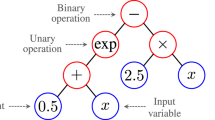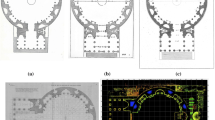Abstract
Rocking stones, balanced in counter-intuitive positions, have always intrigued geologists. In our paper, we explain this phenomenon based on high-precision scans of pebbles which exhibit similar behavior. We construct their convex hull and the heteroclinic graph carrying their equilibrium points. By systematic simplification of the arising Morse–Smale complex in a one-parameter process, we demonstrate that equilibria occur typically in highly localized groups (flocks), the number of the latter being reliably observed and determined by hand experiments. Both local and global (micro and macro) equilibria can be either stable or unstable. Most commonly, rocks and pebbles are balanced on stable local equilibria belonging to stable flocks. However, it is possible to balance a convex body on a stable local equilibrium belonging to an unstable flock and this is the intriguing mechanical scenario corresponding to rocking stones. Since outside observers can only reliably perceive flocks, the last described situation will appear counter-intuitive. A comparison between computer experiments and hand experiments reveals that the latter are consistent, that is, the flocks can be reliably counted and the pebble classification system proposed in our previous work is robustly applicable. We also find an interesting logarithmic relationship between the flatness of pebbles and the average number of global equilibrium points, indicating a close relationship between classical shape categories and the new classification system.
Similar content being viewed by others
References
Agarwal PK, Edelsbrunner H, Harer J, Wang Y (2006) Extreme elevation on a 2-manifold. Discrete Comput Geom 36:553–572
Anooshehpoor A, Brune JN, Zeng Y (2004) Methodology for obtaining constraints on ground motion from precariously balanced rocks. Bull Seismol Soc Am 94:285–303
Arnold VI (1998) Ordinary differential equations, 10th edn. MIT Press, Cambridge
Bell JW, Brune JN, Liu T, Zreda M, Yount JC (1998) Dating precariously balanced rocks in seismically active parts of California and Nevada. Geology 26:495–498
Bourke M, Viles H, Nicoli J, Lyew-Ayee P, Ghent R, Holmlund J (2008) Innovative applications of laser scanning and rapid prototype printing to rock breakdown experiments. Earth Surf Processes Landf 33:1614–1621
Bremer PT, Edelsbrunner H, Hamann B, Pascucci V (2003) A multiresolution data structure for two-dimensional Morse–Smale functions. In: Proc of the 14th IEEE visualization conference (VIS2003)
Brune JN, Anooshehpoor A, Purvance MD, Brune RJ (2006) Band of precariously balanced rocks between the Elsinore and San Jacinto, California, fault zones: constraints on ground motion for large earthquakes. Geology 34:137–140
Cazals F, Chazal F, Lewiner T (2003) Molecular shape analysis based upon the Morse–Smale complex and the Connoly function. In: Proc of the 19th ACM symposium on computational geometry (Socg’03), San Diego, California
CGAL, Computational Geometry Algorithms Library, http://www.cgal.org
Domokos G, Lángi Zs, Szabó T (2011) On the equilibria of finely discretized curves and surfaces. Monatsh Math. doi:10.1007/s00605-011-0361-x
Domokos G, Papadopoulos J, Ruina A (1994) Static equilibria of rigid bodies: is there anything new? J Elast 36:59–66
Domokos G, Sipos A, Szabó T, Várkonyi P (2010) Pebbles, shapes and equilibria. Math Geosci 42:29–47
Edelsbrunner H, Harer J, Zomorodian A (2003) Hierarchical Morse–Smale complexes for piecewise linear 2-manifolds. Discrete Comput Geom 30:87–107
Edelsbrunner H, Harer J, Natarajan A, Pascucci V (2003) Hierarchical Morse–Smale complexes for piecewise linear 3-manifolds. In: Proc of the 19th ACM symposium on computational geometry (Socg’03), San Diego, California
Forman R (1998) Morse Theory for cell complexes. Adv Math 134:90–145
Graham DJ, Midgley NG (2000) Graphical representation of particle shape using triangular diagrams: an Eexcel spreadsheet method. Earth Surf Processes Landf 25:1473–1477
Healy J (1892) Prehistoric stone monuments of Brittany. JRSAI 2:213–220
Heritage GL, Hetherington D (2007) Towards a protocol for laser scanning in fluvial geomorphology. Earth Surf Processes Landf 32:66–74
Illenberger W (1991) Pebble shape (and size!). J Sedimen Res 61:756
Linton DE (1955) The problem of tors. Geogr J 121:470–481
Macmillan RA, Martin TC, Earle TJ, Mcnabb DH (2003) Automated analysis and classification of landforms using high-resolution digital elevation data: applications and issues. Can J Remote Sens 29:592–606
Nagihara S, Mulligan KR, Xiong W (2004) Use of a three-dimensional laser scanner to digitally capture the topography of sand dunes in high spatial resolution. Earth Surf Processes Landf 29:391–398
Natarajan V, Bremer PT, Wang Y, Pascucci V, Hamann B (2006) Segmenting molecular surfaces. Comput Aided Geom Des 23:495–509
Palmer J, Neilson RA (1962) The origin of granite tors on Dartmoor, Devonshire. Proc Yorks Geol Soc 33:315–340
Rock Balancing (2011) In: Wikipedia, the free Encyclopedia. Wikimedia foundation, Inc. http://en.wikipedia.org/wiki/Rock_balancing. Accessed 16 Aug 2011
Rocking Stones (2011) In: Wikipedia, the free Encyclopedia. Wikimedia foundation, Inc. http://en.wikipedia.org/wiki/Rocking_Stones. Accessed 16 Aug 2011
Sneed E, Folk RL (1958) Pebbles in the lower Colorado River, Texas, a study in particle morphogenesis. J Geol 66:114–150
Szabó T, Domokos G (2010) A new classification system for pebble and crystal shapes based on static equilibrium points. Cent Eur Geol 53:1–19
Zamfirescu T (1995) How do convex bodies sit? Mathematika 42:179–181
Zingg T (1935) Beitrag zur Schotteranalyse. Schweiz Mineral Petrogr Mitt 15:39–140
Author information
Authors and Affiliations
Corresponding author
Rights and permissions
About this article
Cite this article
Domokos, G., Sipos, A.Á. & Szabó, T. The Mechanics of Rocking Stones: Equilibria on Separated Scales. Math Geosci 44, 71–89 (2012). https://doi.org/10.1007/s11004-011-9378-x
Received:
Accepted:
Published:
Issue Date:
DOI: https://doi.org/10.1007/s11004-011-9378-x




